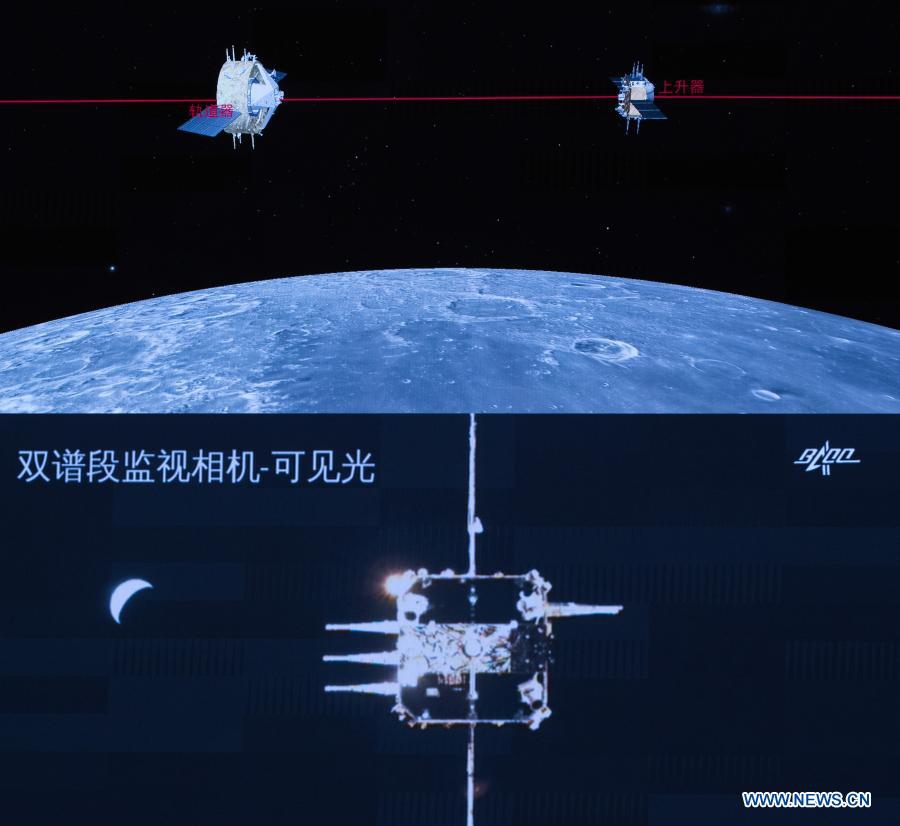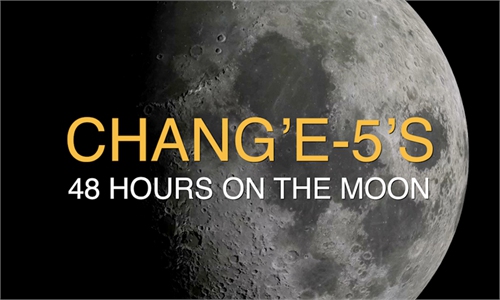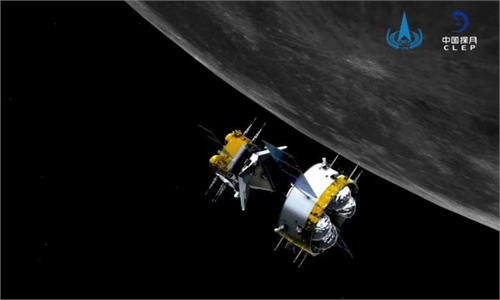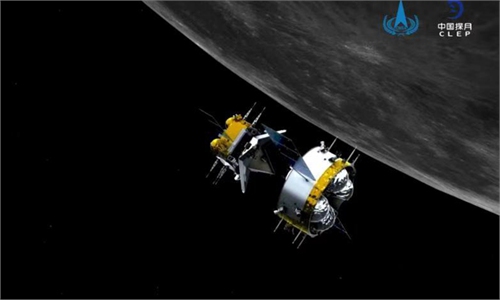Chang'e-5 completes China's first docking in lunar orbit
'A kiss from space' of great value to future deep-space missions

Screen image captured at Beijing Aerospace Control Center in Beijing, capital of China, Dec. 6, 2020 shows the rendezvous and docking of the ascender of China's Chang'e-5 probe with the orbiter-returner combination. The ascender of China's Chang'e-5 probe successfully rendezvoused and docked with the orbiter-returner combination in lunar orbit at 5:42 a.m. (Beijing Time) on Sunday, the China National Space Administration (CNSA) has announced. This is the first time Chinese spacecraft have carried out rendezvous and docking in lunar orbit. (Xinhua/Jin Liwang)
After a successful liftoff from the lunar surface and rendezvous in lunar orbit, China's Chang'e-5 lunar probe docked with the orbital module on Sunday, with the lunar samples safely transferred to the return capsule, China's first successful attempt at such a maneuver made possible by cutting-edge technologies.
It is a visionary endeavor that lays a technological foundation for future deep-space exploration, observers said.
The probe's ascender successfully docked with the orbital module in lunar orbit on Sunday at 5:42 am, some 380,000 kilometers from the Earth, and completed the lunar sample transfer at 6:12 am from the ascender to the return capsule, the Global Times learned from the China National Space Administration (CNSA).
It is the first time China has achieved a probe rendezvous and docking in lunar orbit. Under autonomous control from the probe and long-distance guidance from the command team in ground control, the orbital module approached the ascender after it launched from the moon, and captured it in a smooth operation.
The return capsule carrying the lunar materials weighing two kilograms separated from the orbital module in lunar orbit at 12:35 pm on Sunday, and now it is waiting for a suitable window to return to the Earth, CNSA said.
The docking maneuver was described by Chinese netizens as "a kiss from space," as thousands of stargazers watch every step of the probe's odyssey. Space fans have witnessed several major breakthroughs in China's aerospace history.
Sources close to the mission previously told the Global Times that the Chang'e-5 probe is set to achieve four firsts in China's aerospace history.
It has already achieved three of these, including the first-ever robotic sample collecting on lunar surface, a complex takeoff from the rough lunar terrain, and most challenging of all, the rendezvous and docking in lunar orbit.
One of the most crucial devices applied during the spacecraft's docking maneuver was a pair of microwave radars, installed on both the ascender and the orbiter, which helps measure and adjust the positions of the two sections under fast-changing distances, and transmit data during the process.
This technology has been applied previously to multiple rendezvous and docking operations in low Earth orbit, including the crewed Shenzhou mission.
However, it is the first time the technology has been tried in lunar orbit 380,000 kilometers from the Earth, with the maneuver becoming a world-leading innovation in the aerospace field.
"Compared with low-Earth orbit, satellite services can't be used for navigation in lunar orbit. The only means of communication is through microwave radar," said Sun Wu, chief engineer of the technology. "The lunar orbit has a more complicated environment, placing some extremely harsh requirements for the probe to overcome the influences from space, such as lunar gravity."
The chief designer of the docking operation described the microwave radar as eyes that can "see thousands of miles," and ears that can "hear sounds from afar," which will ensure the Chang'e-5 probe's smooth return.
Another cutting-edge technology is a grabbing machine used to transfer the samples in lunar orbit, resembling the action of a person holding sticks. This technology is also a world's first that ensured the safe handover of the valuable package in space.
"The distance from the Earth to the moon means a time delay, so there's only a short time window for the maneuver. It means a highly efficient docking process in just 21 seconds," Sun said.
Chinese researchers started working on simulations in 2011, conducting 661 docking tests and 518 sample transfer tests.
The rendezvous and docking could be of great value to other deep-space or even manned missions in the future, the significance of which would be no less than the Apollo missions, once the calling card of human lunar exploration activities during the Cold War, Chinese analysts said.
"It has become a milestone for China's aerospace development," Song Zhongping, an aerospace expert and TV commentator, said, calling it "a visionary practice that lays a technological foundation for future deep-space explorations."
It also verifies the viability of manned lunar landing missions, and even the construction of a lunar research base, or Mars missions, he told the Global Times.
Andrew Jones, a Finland-based journalist for space.com, a premier source of space exploration information around the world, tweeted his congratulations to China, saying that the rendezvous and docking between the ascent vehicle and the orbiter is a "massive step toward bringing home fresh lunar samples."
China's final breakthrough is the return trajectory, with the capsule traveling at the speed of 11 kilometers per second, reaching second cosmic velocity.
Sources told the Global Times that designers with the China Academy of Space Technology under CASC have designed a semi-ballistic reentry to help the high-speed spacecraft return to the Earth safely.
Similar to the way a stone can skip over water, the return capsule will sprint into the atmosphere and then ascend again out of it, in order to reduce its speed to first cosmic velocity, which is around 8 kilometers per second, before landing safely at its designated site.
Wang Ya'nan, chief editor of Aerospace Knowledge magazine, told the Global Times that this measure will greatly reduce the risk of damaging the return capsule and will ensure the sample's safety.
He added that the highly complex, forward-looking technology applied in this project could be regarded as "an unmanned task that lays the foundation for future manned lunar missions."
The reentry capsule will carry the lunar sample and is scheduled to land in North China's Inner Mongolia Autonomous Region in mid-December.



